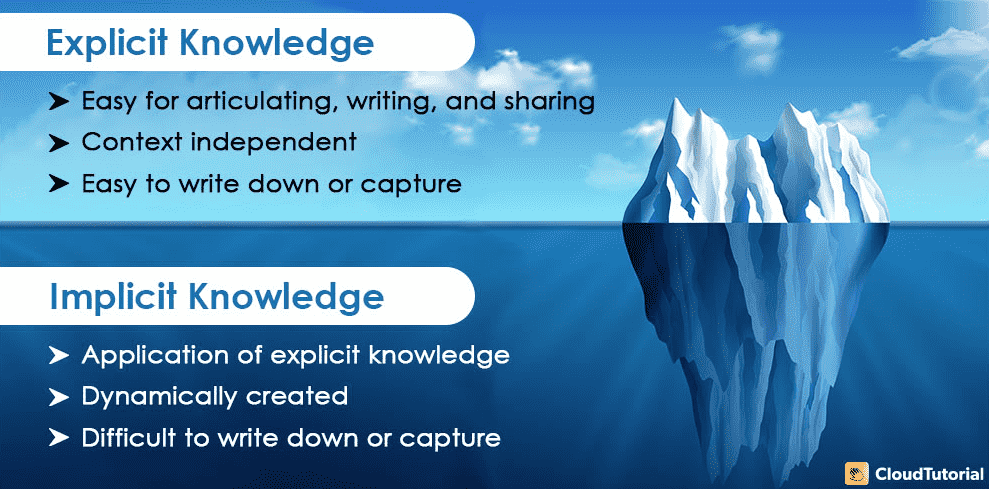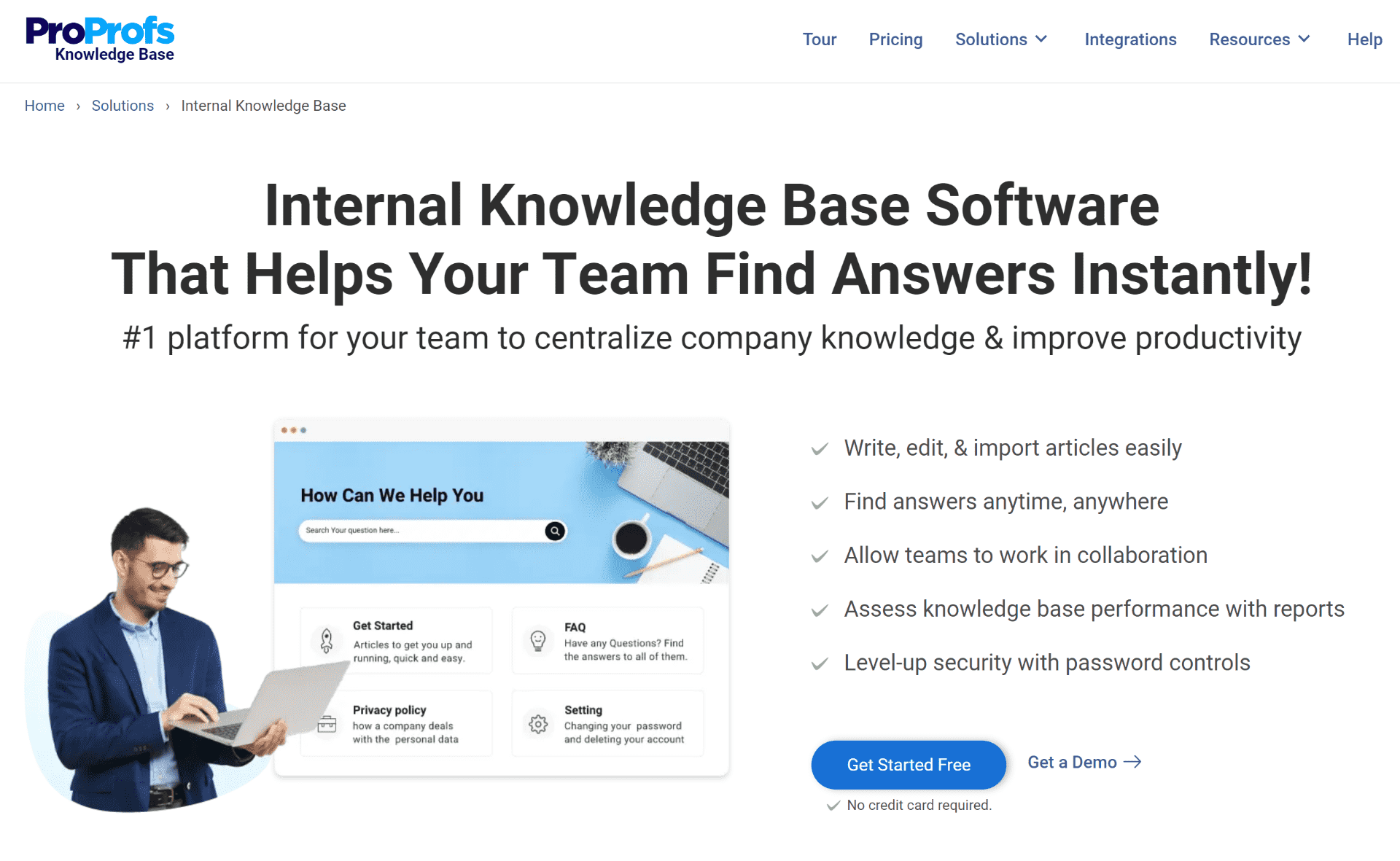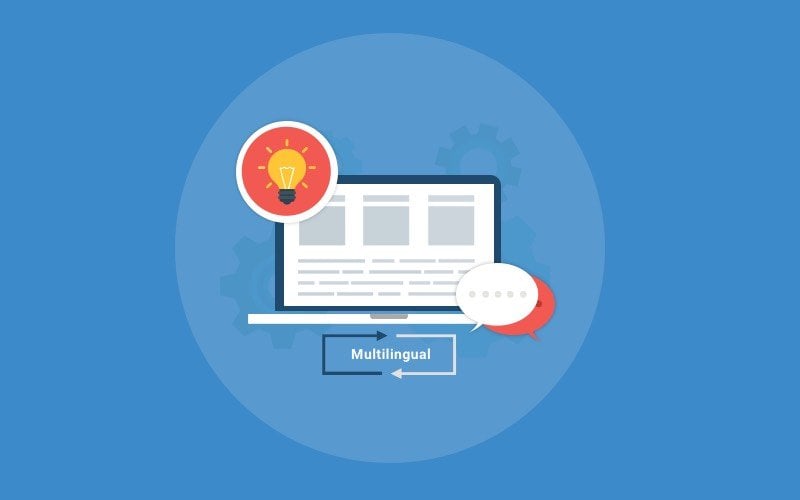Imagine having to make quick decisions in a fast-paced, ever-changing market!
What’s the secret to thriving and succeeding in such a competitive market?
The answer lies in grasping implicit knowledge and unlocking its hidden potential to improve communication and collaboration.
By capturing implicit knowledge, you can equip your workforce with the right skills, expertise, and insights so that they work productively and ensure long-term business success.
In this blog, we will discover how embracing implicit knowledge can optimize your strategic innovation, decision-making, and competitiveness. Let’s get started.
What Is Implicit Knowledge?
Implicit knowledge is the type of knowledge that is difficult to articulate, document, or transfer. It is the ‘how’ behind a particular task, explaining the procedure to complete it.
Implicit knowledge is tacit and personal in nature. It stays in the minds of those with valuable experience, expertise, or skills.
For instance, implicit knowledge consists of the tips, tricks, or secrets you learn from real-life situations and on-the-job learning experiences. You can also see it as the intuition, creativity, or judgment you use to perform your routine tasks or solve complicated problems.
Implicit Knowledge vs. Explicit Knowledge

Explicit knowledge, on the other hand, is easy to articulate, document, or transfer. It is the ‘what’ behind a particular task, outlining the facts, rules, or principles you must know to complete it.
Explicit knowledge is codified and impersonal. It can be stored in books, documents, or databases. Some examples include research reports, data sheets, employee handbooks, and user manuals.
Explicit knowledge can include the information, data, or instructions you learn from formal education or training sessions. You can also consider it as the logic, analysis, or reasoning you use to perform tasks or solve problems.
Both implicit and explicit knowledge are essential for your organization, but implicit knowledge is often more valuable and easier to manage than explicit knowledge.
Since implicit knowledge is comparatively raw and experience-based, it can give you a competitive edge, improve performance, foster innovation, and enhance customer satisfaction.
You must be careful, though, as it can get lost, forgotten, or ignored if you don’t capture and share it appropriately.
Benefits of Capturing Implicit Knowledge for Your Team
Recording and managing implicit knowledge helps your team make the right decisions and work with optimum productivity, creativity, and innovation. The benefits of capturing implicit knowledge for your team are:
Enhancing Decision-Making and Problem-Solving
Implicit knowledge is the information gained from practical experiences, failures, and successes.
By capturing this knowledge, you can equip your teams with diverse perspectives to draw upon when making important decisions and solving varying queries.
This collection of insights enables faster, more informed choices, minimizing the risk of mistakes and enabling innovative solutions.
Boosting Employee Engagement and Collaboration
Capturing implicit knowledge helps your employees by giving them access to the diverse wisdom of their teammates, seniors, and managers.
When captured and shared effectively, this knowledge enables collaboration and mentorship as your employees learn from each other’s experiences, skills, and insights.
You can create a holistic knowledge-sharing ecosystem to enhance engagement and expertise across the workforce by providing your people with a supportive environment where both newcomers and seasoned professionals contribute.
Fosters Innovation
Implicit knowledge often contains unconventional or creative problem-solving approaches that can spark innovation within your business.
By capturing these intelligent strategies and diverse viewpoints, you can nurture a culture of adaptability and encourage your teams to explore new dimensions for growth.
Implicit knowledge enables a treasure of fresh ideas that can lead to novel products, services, and processes to keep the business competitive and relevant in a quickly evolving landscape.
Improves Customer Service and Experience
Implicit knowledge enhances customer interactions by helping employees better understand customer needs and address issues more effectively.
When service agents utilize the reservoir of implicit knowledge, they can offer more human-centric, personalized solutions, understand customer concerns, and provide more effective support.
This enables improved customer satisfaction, loyalty, and a stronger brand reputation that distinguishes your business in the market.
Facilitating Continuity and Reducing Knowledge Loss
As experienced professionals retire or move on to other roles, a risk of losing long-accumulated knowledge arises.
Recording implicit knowledge and employing an efficient knowledge transfer strategy ensure that the unique insights, techniques, and perspectives are preserved and accessible to all the team members.
This continuity safeguards against knowledge gaps, prevents disruptions, and maintains a consistent performance even during workforce changes.
Accelerated Onboarding and Skill Development
New joiners can quickly become productive contributors with access to implicit knowledge. This diverse set of insights helps you optimize the onboarding process and gives employees the opportunity to learn from their colleagues and seniors.
They can utilize the established best practices, user guides, and employee handbooks to avoid common pitfalls and integrate seamlessly into the team’s operations.
How to Capture and Share Implicit Knowledge in Your Organization?
Capturing, sharing, and managing implicit knowledge in your company can be challenging because it demands time, effort, and commitment from both the knowledge holders and the knowledge seekers.
However, the benefits far outweigh the challenges as it can create value, impact, and results for both the individual and the organization.
Here are some steps that you can follow to capture and share implicit knowledge in your organization:
Identify Valuable Implicit Knowledge
Begin with in-depth one-on-one conversations, focus groups, or surveys with experienced employees across different departments.
Motivate them to reflect on situations where their experience was critical to decision-making. Record anecdotes and scenarios that showcase their unique insights and approaches, highlighting the value of their implicit knowledge.
It involves actively observing and probing for insights that might not be evident at first glance.
Foster a Knowledge Sharing Culture
Try to create an environment that considers knowledge-sharing a fundamental practice. A considerate leadership plays a vital role in setting the tone.
Organize regular personal meetings where the benefits of implicit knowledge are emphasized. Encourage senior team members to share their experiences openly, showcasing the value of learning from one another. Also use a knowledge-sharing platform.
Use an employee recognition platform that acknowledges and celebrates team members who actively contribute their implicit knowledge, reinforcing the culture of sharing as a cornerstone of organizational growth.
Document and Organize in an Internal Knowledge Base

Utilize a robust internal knowledge base platform to document and categorize implicit knowledge. Create and label dedicated sections for different areas of expertise or domains.
Incorporate a structured format within each section with detailed descriptions, step-by-step procedures, and case studies. Encourage contributors to elaborate on the context in which their insights were applied.
Add multimedia elements like images, videos, or flowcharts to enhance understanding and make the process more engaging. Prioritize clarity and accessibility to ensure any team member can understand and apply the documented insights.
Here is a quick video on an internal knowledge base’s essential features and benefits:
Facilitate Collaborative Learning
Create interactive forums for cross-functional knowledge sharing. Organize workshops, lunch-and-learns, or webinars where team members can delve into specific implicit knowledge topics.
Encourage participants to share real-world examples, scenarios, and challenges they’ve faced. Facilitate a safe environment where new questions are welcomed and experiences are openly discussed.
Have an experienced professional to moderate discussions and ensure that all participants have the opportunity to contribute. This step promotes active engagement, the exchange of insights, and the cultivation of a rich learning environment.
Regularly Update and Reinforce
Ensure that the internal knowledge base is accurate and relevant by assigning individuals or teams to oversee it. Establish a structured process for continuous review and updating of the content.
Utilize automated reminders or notifications to prompt contributors to share their experiences and update content.
Regularly communicate the value of the knowledge base, emphasizing its role in improving decision-making, problem-solving, and overall team efficiency.
To know how to collaborate as a team to create a knowledge base, watch this short yet informative video:
FREE. All Features. FOREVER!
Try our Forever FREE account with all premium features!
Examples of Implicit Knowledge
To give you examples of how you can capture and share implicit knowledge in your organization, here are some scenarios from different domains:
Marketing
Suppose you have a content marketer who can write catchy headlines for your blog posts. You can record their implicit knowledge by noticing how they write the headlines, asking them what makes a good headline, and recording their tips and tricks.
You can then document your headline writing steps using text and images, organize your files using categories and tags, and store your documents using an internal knowledge base.
You can then share those documents using email or chat with other team members who need to write headlines for their articles.
Sales
Picture a sales representative who can close deals with your customers. You can capture their implicit knowledge (shadowing sensitive information, of course), listen to how they handle their objections, and film their secrets and techniques.
First, record their negotiation process using video and audio. Next, organize their documents using hierarchies and trees. Then, store these documents in a knowledge base.
Finally, share these documents with other sales teammates who need to close deals with customers..
Engineering
Imagine you have an engineer who knows how to design a new product for your business. You can capture their implicit knowledge by covering how they create the product prototype, asking them about the design principles, and writing down their intuition and creativity.
First, document their design process using text and diagrams. Next, organize these documents using levels and types. Then, store these documents using knowledge base software.
Finally, share these documents with other engineering team members who need to design new products for your organization..
Customer Support
If you have a customer support professional who is an expert in calming frustrated customers, you can capture their implicit knowledge by creating a centralized knowledge base with FAQs, troubleshooting guides, etc.
You can document their insights into easy-to-understand guides with real examples. Organize them by different customer situations. Keep it well organized using a knowledge base tool.
Share their insights with your customer support team through video calls or online meetings. By learning from their implicit knowledge, your team can conduct better interactions, improving customer satisfaction.
Product Development
Every company has a product development professional who can speed up the creation process. Learn from their methods, understand their techniques, and keep track of their strategies.
Turn what you’ve learned into simple, detailed guides and help files with visuals. Organize everything by project complexity and stages.
Share the curated insights with your product development team through webinars or virtual meetings. Your team can use their implicit knowledge to create better products, driving organizational growth.
Implicit Knowledge for Maximum Employee Productivity & Collaboration
As we discussed, capturing implicit knowledge effectively is crucial for your organization because it provides a competitive advantage, enhances performance, fosters innovation, and improves customer satisfaction.
However, it is essential to note that implicit knowledge can get lost, forgotten, or ignored if you don’t capture and share it appropriately, so you must learn to do so.
And that’s where ProProfs Knowledge Base can help you create and manage online documentation for your business. You can use it to capture and share your implicit knowledge in an easy, effective, and engaging way.
You can utilize its AI-powered, rich text editor to write and edit content. Make use of its meticulously designed pre-made templates to customize your knowledge base.
 Tips
Tips
We’d love to hear your tips & suggestions on this article!
FREE. All Features. FOREVER!
Try our Forever FREE account with all premium features!

 We'd love your feedback!
We'd love your feedback! Thanks for your feedback!
Thanks for your feedback!







